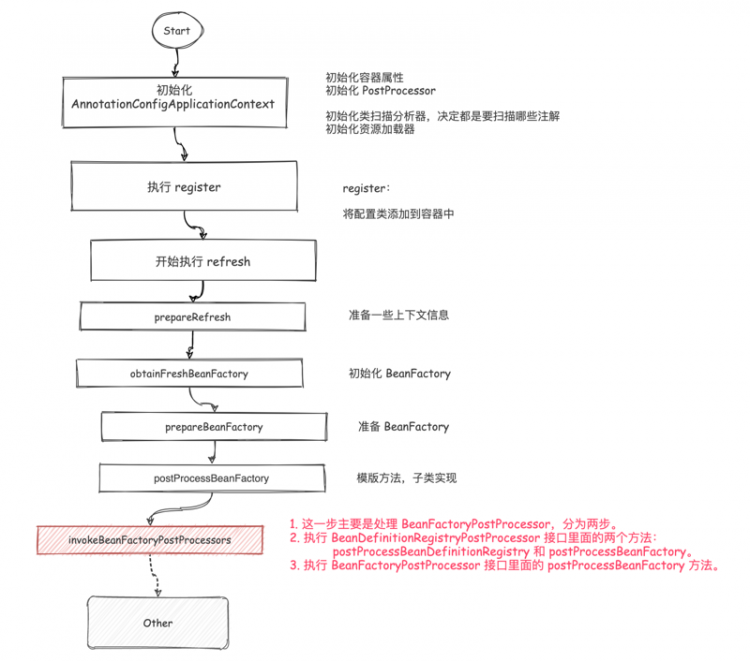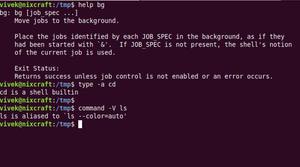通过BeanPostProcessor理解Spring中Bean的生命周期
本文内容纲要:
- Spring bean的生命周期- 注册BeanPostProcessor
- BeanFactory.getBean()(注册Bean)
- createBean,调用的开端
- 执行 postProcessBeforeInstantiation方法的时机
- postProcessAfterInstantiation调用的地方
- postProcessPropertyValues调用的地方
- InstantiationAwareBeanPostProcessor总结
通过BeanPostProcessor理解Spring中Bean的生命周期及AOP原理
Spring源码解析(十一)Spring扩展接口InstantiationAwareBeanPostProcessor解析
Spring bean的生命周期
Spring作为一个优秀的框架,拥有良好的可扩展性。Spring对对象的可扩展性主要就是依靠InstantiationAwareBeanPostProcessor和BeanPostProcessor来实现的。
- InstantiationAwareBeanPostProcessor 主要是作用于实例化阶段。
- BeanPostProcessor 主要作用与 初始化阶段。
注册BeanPostProcessor
InstantiationAwareBeanPostProcessor代表了Spring的另外一段生命周期:实例化。先区别一下Spring Bean的实例化和初始化两个阶段的主要作用:
1、实例化—-实例化的过程是一个创建Bean的过程,即调用Bean的构造函数,单例的Bean放入单例池中
2、初始化—-初始化的过程是一个赋值的过程,即调用Bean的setter,设置Bean的属性
之前的BeanPostProcessor作用于过程(2)前后,现在的InstantiationAwareBeanPostProcessor则作用于过程(1)前后;
InstantiationAwareBeanPostProcessor接口继承BeanPostProcessor接口,它内部提供了3个方法,再加上BeanPostProcessor接口内部的2个方法,所以实现这个接口需要实现5个方法。InstantiationAwareBeanPostProcessor接口的主要作用在于目标对象的实例化过程中需要处理的事情,包括实例化对象的前后过程以及实例的属性设置
public AnnotationConfigApplicationContext(Class<?>... annotatedClasses) { this();
register(annotatedClasses);
refresh();
}
applicationContext构造方法中调用refresh()方法
refresh() 方法中这里主要关心两个放
registerBeanPostProcessors(beanFactory); 注册BeanPostProcessor
finishBeanFactoryInitialization(beanFactory); 注册余下的Singletions Bean
public void refresh() throws BeansException, IllegalStateException {
// Register bean processors that intercept bean creation.
registerBeanPostProcessors(beanFactory);
// Instantiate all remaining (non-lazy-init) singletons.
finishBeanFactoryInitialization(beanFactory);
}
public static void registerBeanPostProcessors( ConfigurableListableBeanFactory beanFactory, AbstractApplicationContext applicationContext) {
String[] postProcessorNames = beanFactory.getBeanNamesForType(BeanPostProcessor.class, true, false);
// Register BeanPostProcessorChecker that logs an info message when
// a bean is created during BeanPostProcessor instantiation, i.e. when
// a bean is not eligible for getting processed by all BeanPostProcessors.
int beanProcessorTargetCount = beanFactory.getBeanPostProcessorCount() + 1 + postProcessorNames.length;
beanFactory.addBeanPostProcessor(new BeanPostProcessorChecker(beanFactory, beanProcessorTargetCount));
// Separate between BeanPostProcessors that implement PriorityOrdered,
// Ordered, and the rest.
List<BeanPostProcessor> priorityOrderedPostProcessors = new ArrayList<>();
List<BeanPostProcessor> internalPostProcessors = new ArrayList<>();
List<String> orderedPostProcessorNames = new ArrayList<>();
List<String> nonOrderedPostProcessorNames = new ArrayList<>();
for (String ppName : postProcessorNames) {
if (beanFactory.isTypeMatch(ppName, PriorityOrdered.class)) {
BeanPostProcessor pp = beanFactory.getBean(ppName, BeanPostProcessor.class);
priorityOrderedPostProcessors.add(pp);
if (pp instanceof MergedBeanDefinitionPostProcessor) {
internalPostProcessors.add(pp);
}
}
else if (beanFactory.isTypeMatch(ppName, Ordered.class)) {
orderedPostProcessorNames.add(ppName);
}
else {
nonOrderedPostProcessorNames.add(ppName);
}
}
// First, register the BeanPostProcessors that implement PriorityOrdered.
sortPostProcessors(priorityOrderedPostProcessors, beanFactory);
registerBeanPostProcessors(beanFactory, priorityOrderedPostProcessors);
// Next, register the BeanPostProcessors that implement Ordered.
List<BeanPostProcessor> orderedPostProcessors = new ArrayList<>();
for (String ppName : orderedPostProcessorNames) {
BeanPostProcessor pp = beanFactory.getBean(ppName, BeanPostProcessor.class);
orderedPostProcessors.add(pp);
if (pp instanceof MergedBeanDefinitionPostProcessor) {
internalPostProcessors.add(pp);
}
}
sortPostProcessors(orderedPostProcessors, beanFactory);
registerBeanPostProcessors(beanFactory, orderedPostProcessors);
// Now, register all regular BeanPostProcessors.
List<BeanPostProcessor> nonOrderedPostProcessors = new ArrayList<>();
for (String ppName : nonOrderedPostProcessorNames) {
BeanPostProcessor pp = beanFactory.getBean(ppName, BeanPostProcessor.class);
nonOrderedPostProcessors.add(pp);
if (pp instanceof MergedBeanDefinitionPostProcessor) {
internalPostProcessors.add(pp);
}
}
registerBeanPostProcessors(beanFactory, nonOrderedPostProcessors);
// Finally, re-register all internal BeanPostProcessors.
sortPostProcessors(internalPostProcessors, beanFactory);
registerBeanPostProcessors(beanFactory, internalPostProcessors);
// Re-register post-processor for detecting inner beans as ApplicationListeners,
// moving it to the end of the processor chain (for picking up proxies etc).
beanFactory.addBeanPostProcessor(new ApplicationListenerDetector(applicationContext));
}
registerBeanPostProcessors
通过beanFactory.getBeanNamesForType来获取所有BeanPostProcessor。
BeanPostProcessor按优先级分为PriorityOrdered,Ordered和其他的,对他们分别进行操作。
- 先beanFactory.getBean进性实例化,
- 再使用sortPostProcessors() 进行排序,
- 最后registerBeanPostProcessors()进行注册。
BeanFactory.getBean()(注册Bean)
protected <T> T doGetBean(final String name, @Nullable final Class<T> requiredType, @Nullable final Object[] args, boolean typeCheckOnly) throws BeansException {
final String beanName = transformedBeanName(name);
Object bean;
//缓存
// Eagerly check singleton cache for manually registered singletons.
Object sharedInstance = getSingleton(beanName);
if (sharedInstance != null && args == null) {
bean = getObjectForBeanInstance(sharedInstance, name, beanName, null);
}
else {
// Fail if we're already creating this bean instance:
// We're assumably within a circular reference.
//判断循环引用,抛异常
if (isPrototypeCurrentlyInCreation(beanName)) {
throw new BeanCurrentlyInCreationException(beanName);
}
// Check if bean definition exists in this factory.
BeanFactory parentBeanFactory = getParentBeanFactory();
// this.beanDefinitionMap.containsKey(beanName); 就是判断有没有BeanDefinition
if (parentBeanFactory != null && !containsBeanDefinition(beanName)) {
// Not found -> check parent.
String nameToLookup = originalBeanName(name);
if (parentBeanFactory instanceof AbstractBeanFactory) {
return ((AbstractBeanFactory) parentBeanFactory).doGetBean(
nameToLookup, requiredType, args, typeCheckOnly);
}
else if (args != null) {
// Delegation to parent with explicit args.
return (T) parentBeanFactory.getBean(nameToLookup, args);
}
else {
// No args -> delegate to standard getBean method.
return parentBeanFactory.getBean(nameToLookup, requiredType);
}
}
if (!typeCheckOnly) {
markBeanAsCreated(beanName);
}
try {
final RootBeanDefinition mbd = getMergedLocalBeanDefinition(beanName);
checkMergedBeanDefinition(mbd, beanName, args);
// Guarantee initialization of beans that the current bean depends on.
// 获取bean的依赖,实例化bean前先实例化依赖。
String[] dependsOn = mbd.getDependsOn();
if (dependsOn != null) {
for (String dep : dependsOn) {
if (isDependent(beanName, dep)) {
throw new BeanCreationException(mbd.getResourceDescription(), beanName,
"Circular depends-on relationship between '" + beanName + "' and '" + dep + "'");
}
registerDependentBean(dep, beanName);
try {
getBean(dep);
}
catch (NoSuchBeanDefinitionException ex) {
throw new BeanCreationException(mbd.getResourceDescription(), beanName,
"'" + beanName + "' depends on missing bean '" + dep + "'", ex);
}
}
}
//创建实例
// Create bean instance.
if (mbd.isSingleton()) {
sharedInstance = getSingleton(beanName, () -> {
try {
return createBean(beanName, mbd, args);
}
catch (BeansException ex) {
// Explicitly remove instance from singleton cache: It might have been put there
// eagerly by the creation process, to allow for circular reference resolution.
// Also remove any beans that received a temporary reference to the bean.
destroySingleton(beanName);
throw ex;
}
});
bean = getObjectForBeanInstance(sharedInstance, name, beanName, mbd);
}
else if (mbd.isPrototype()) {
// It's a prototype -> create a new instance.
Object prototypeInstance = null;
try {
beforePrototypeCreation(beanName);
prototypeInstance = createBean(beanName, mbd, args);
}
finally {
afterPrototypeCreation(beanName);
}
bean = getObjectForBeanInstance(prototypeInstance, name, beanName, mbd);
}
else {
String scopeName = mbd.getScope();
final Scope scope = this.scopes.get(scopeName);
if (scope == null) {
throw new IllegalStateException("No Scope registered for scope name '" + scopeName + "'");
}
try {
Object scopedInstance = scope.get(beanName, () -> {
beforePrototypeCreation(beanName);
try {
return createBean(beanName, mbd, args);
}
finally {
afterPrototypeCreation(beanName);
}
});
bean = getObjectForBeanInstance(scopedInstance, name, beanName, mbd);
}
}
}
}
// Check if required type matches the type of the actual bean instance.
if (requiredType != null && !requiredType.isInstance(bean)) {
try {
T convertedBean = getTypeConverter().convertIfNecessary(bean, requiredType);
if (convertedBean == null) {
throw new BeanNotOfRequiredTypeException(name, requiredType, bean.getClass());
}
return convertedBean;
}
}
return (T) bean;
}
doGetBean
- 先getSingleton()从缓存中获取Bean,如果没有则创建。
- 创建过程先检查有无循环依赖,有则抛出异常。
- 实例化bean前先实例化所依赖的对象。
createBean,调用的开端
@Override protected Object createBean(String beanName, RootBeanDefinition mbd, Object[] args) throws BeanCreationException {
// Give BeanPostProcessors a chance to return a proxy instead of the target bean instance.
Object bean = resolveBeforeInstantiation(beanName, mbdToUse);
if (bean != null) {
return bean;
}
//省略....
Object beanInstance = doCreateBean(beanName, mbdToUse, args);
return beanInstance;
}
上面代码里面看到,在执行doCreateBean之前有resolveBeforeInstantiation方法;doCreateBean是创建bean的方法;
resolveBeforeInstantiation是 判断执行InstantiationAwareBeanPostProcessor.postProcessBeforeInstantiation的接方法实现;
下面看看执行的依据:
执行 postProcessBeforeInstantiation方法的时机
/** * Apply before-instantiation post-processors, resolving whether there is a
* before-instantiation shortcut for the specified bean.
* @param beanName the name of the bean
* @param mbd the bean definition for the bean
* @return the shortcut-determined bean instance, or {@code null} if none
*/
protected Object resolveBeforeInstantiation(String beanName, RootBeanDefinition mbd) {
Object bean = null;
//如果beforeInstantiationResolved还没有设置或者是false(说明还没有需要在实例化前执行的操作)
if (!Boolean.FALSE.equals(mbd.beforeInstantiationResolved)) {
// 判断是否有注册过InstantiationAwareBeanPostProcessor类型的bean
if (!mbd.isSynthetic() && hasInstantiationAwareBeanPostProcessors()) {
Class<?> targetType = determineTargetType(beanName, mbd);
if (targetType != null) {
//执行
bean = applyBeanPostProcessorsBeforeInstantiation(targetType, beanName);
if (bean != null) {
bean = applyBeanPostProcessorsAfterInitialization(bean, beanName);
}
}
}
mbd.beforeInstantiationResolved = (bean != null);
}
return bean;
}
protected Object applyBeanPostProcessorsBeforeInstantiation(Class<?> beanClass, String beanName) {
for (BeanPostProcessor bp : getBeanPostProcessors()) {
if (bp instanceof InstantiationAwareBeanPostProcessor) {
InstantiationAwareBeanPostProcessor ibp = (InstantiationAwareBeanPostProcessor) bp;
Object result = ibp.postProcessBeforeInstantiation(beanClass, beanName);
//只要有一个result不为null;后面的所有 后置处理器的方法就不执行了,直接返回(所以执行顺序很重要)
if (result != null) {
return result;
}
}
}
return null;
}
@Override
public Object applyBeanPostProcessorsAfterInitialization(Object existingBean, String beanName)
throws BeansException {
Object result = existingBean;
for (BeanPostProcessor beanProcessor : getBeanPostProcessors()) {
result = beanProcessor.postProcessAfterInitialization(result, beanName);
//如果返回null;后面的所有 后置处理器的方法就不执行,直接返回(所以执行顺序很重要)
if (result == null) {
return result;
}
}
return result;
}
上面代码说明:
如果postProcessBeforeInstantiation方法返回了Object是null;那么就直接返回,调用doCreateBean方法();
如果postProcessBeforeInstantiation返回不为null;说明修改了bean对象;然后这个时候就立马执行postProcessAfterInitialization方法(注意这个是初始化之后的方法,也就是通过这个方法实例化了之后,直接执行初始化之后的方法;中间的实例化之后 和 初始化之前都不执行);
在调用postProcessAfterInitialization方法时候如果返回null;那么就直接返回,调用doCreateBean方法();(初始化之后的方法返回了null,那就需要调用doCreateBean生成对象了)
在调用postProcessAfterInitialization时返回不为null;那这个bean就直接返回给ioc容器了 初始化之后的操作 是这里面最后一个方法了;
通过上面的描述,我们其实可以在这里生成一个代理类:原文
postProcessAfterInstantiation调用的地方
代码往后面执行走到了populateBean里面;这个主要是给bean填充属性的;实例化已经在 pupulateBean之前已经完成了
//实例化bean;选择不同策略来实例化bean instanceWrapper = createBeanInstance(beanName, mbd, args);
protected void populateBean(String beanName, RootBeanDefinition mbd, BeanWrapper bw) {
//省略。。。。
if (!mbd.isSynthetic() && hasInstantiationAwareBeanPostProcessors()) {
for (BeanPostProcessor bp : getBeanPostProcessors()) {
if (bp instanceof InstantiationAwareBeanPostProcessor) {
InstantiationAwareBeanPostProcessor ibp = (InstantiationAwareBeanPostProcessor) bp;
//执行postProcessAfterInstantiation方法
if (!ibp.postProcessAfterInstantiation(bw.getWrappedInstance(), beanName)) {
continueWithPropertyPopulation = false;
break;
}
}
}
}
//省略....
//下面的代码是判断是否需要执行postProcessPropertyValues;改变bean的属性
boolean hasInstAwareBpps = hasInstantiationAwareBeanPostProcessors();
boolean needsDepCheck = (mbd.getDependencyCheck() != RootBeanDefinition.DEPENDENCY_CHECK_NONE);
if (hasInstAwareBpps || needsDepCheck) {
PropertyDescriptor[] filteredPds = filterPropertyDescriptorsForDependencyCheck(bw, mbd.allowCaching);
if (hasInstAwareBpps) {
for (BeanPostProcessor bp : getBeanPostProcessors()) {
if (bp instanceof InstantiationAwareBeanPostProcessor) {
InstantiationAwareBeanPostProcessor ibp = (InstantiationAwareBeanPostProcessor) bp;
pvs = ibp.postProcessPropertyValues(pvs, filteredPds, bw.getWrappedInstance(), beanName);
if (pvs == null) {
return;
}
}
}
}
if (needsDepCheck) {
checkDependencies(beanName, mbd, filteredPds, pvs);
}
}
//这里才是正在讲 属性值 真正的设置的我们的实例对象里面;之前postProcessPropertyValues这个还只是单纯的改变PropertyValues
//最后还是要通过PropertyValues 设置属性到实例对象里面的
applyPropertyValues(beanName, mbd, bw, pvs);
}
这个postProcessAfterInstantiation返回值要注意,因为它的返回值是决定要不要调用postProcessPropertyValues方法的其中一个因素(因为还有一个因素是mbd.getDependencyCheck());如果该方法返回false,并且不需要check,那么postProcessPropertyValues就会被忽略不执行;如果返回true,postProcessPropertyValues就会被执行
postProcessPropertyValues调用的地方
原文
postProcessPropertyValues修改属性,但是要注意postProcessAfterInstantiation返回true;
InstantiationAwareBeanPostProcessor总结
1. InstantiationAwareBeanPostProcessor接口继承BeanPostProcessor接口,它内部提供了3个方法,再加上BeanPostProcessor接口内部的2个方法,所以实现这个接口需要实现5个方法。InstantiationAwareBeanPostProcessor接口的主要作用在于目标对象的实例化过程中需要处理的事情,包括实例化对象的前后过程以及实例的属性设置
2. postProcessBeforeInstantiation方法是最先执行的方法,它在目标对象实例化之前调用,该方法的返回值类型是Object,我们可以返回任何类型的值。由于这个时候目标对象还未实例化,所以这个返回值可以用来代替原本该生成的目标对象的实例(比如代理对象)。如果该方法的返回值代替原本该生成的目标对象,后续只有postProcessAfterInitialization方法会调用,其它方法不再调用;否则按照正常的流程走
3. postProcessAfterInstantiation方法在目标对象实例化之后调用,这个时候对象已经被实例化,但是该实例的属性还未被设置,都是null。因为它的返回值是决定要不要调用postProcessPropertyValues方法的其中一个因素(因为还有一个因素是mbd.getDependencyCheck());如果该方法返回false,并且不需要check,那么postProcessPropertyValues就会被忽略不执行;如果返回true,postProcessPropertyValues就会被执行
4. postProcessPropertyValues方法对属性值进行修改(这个时候属性值还未被设置,但是我们可以修改原本该设置进去的属性值)。如果postProcessAfterInstantiation方法返回false,该方法可能不会被调用。可以在该方法内对属性值进行修改
5. 父接口BeanPostProcessor的2个方法postProcessBeforeInitialization和postProcessAfterInitialization都是在目标对象被实例化之后,并且属性也被设置之后调用的
6. Instantiation表示实例化,Initialization表示初始化。实例化的意思在对象还未生成,初始化的意思在对象已经生成
本文内容总结:Spring bean的生命周期,注册BeanPostProcessor,BeanFactory.getBean()(注册Bean),createBean,调用的开端,执行 postProcessBeforeInstantiation方法的时机,postProcessAfterInstantiation调用的地方,postProcessPropertyValues调用的地方,InstantiationAwareBeanPostProcessor总结,
原文链接:https://www.cnblogs.com/fanguangdexiaoyuer/p/10730990.html
以上是 通过BeanPostProcessor理解Spring中Bean的生命周期 的全部内容, 来源链接: utcz.com/z/362494.html






